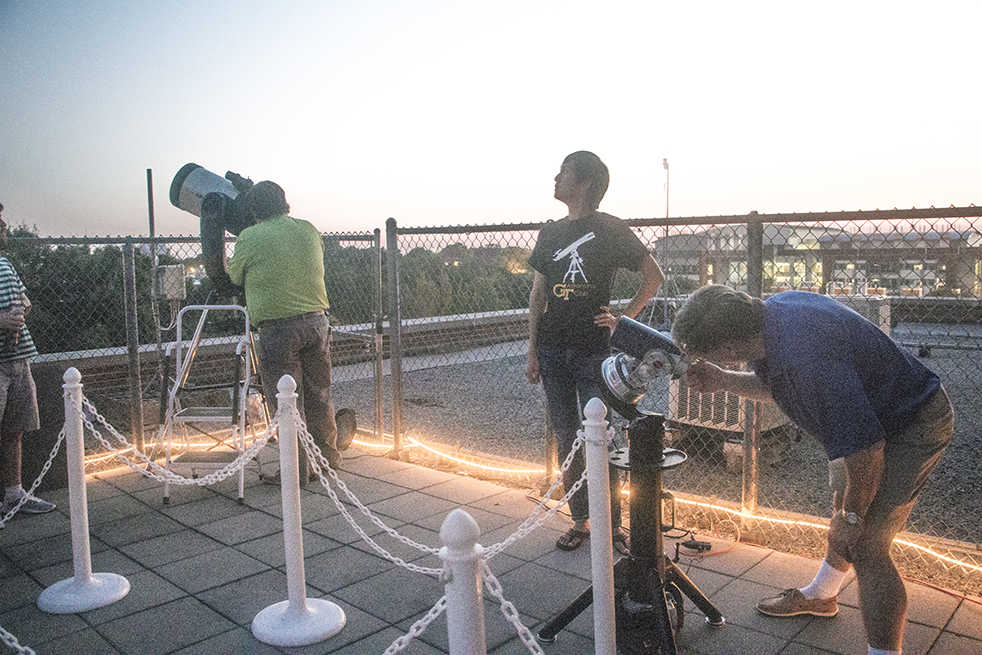Students and members of the community waited with anticipation as the evening sky darkened to the night sky. Once a month, the School of Physics opens the doors to its observatory so that anyone can see the grandeur of the sky.
On these evenings, with the help of Tech’s own telescope, attendees take advantage of the free opportunity to get an up close look at the wonders above.
Every public night begins with a quick thirty-minute talk. It is not a classic boring presentation about textbook topics, though. Rather, it is meant to be an entertaining, easily digestible journey through what makes space so simultaneously awe-inspiring and baffling. Filled with pictures and ways that the information relates to everyday life, everyone leaves both entertained and informed.
Thursday, Sept. 20 was the first public observatory night of the year. This week’s brief talk, led by physics Ph.D. student Yu Qiu, explored the cause and significance of galaxy clusters.
Galaxy clusters are just as they sound: clusters of galaxies held together by the gravity from the large collection of matter, both normal and dark, at its center. The talk shed light on the scale and scope of the universe and gave an important perspective to the experience for those about to see the celestial bodies that make up those clusters with their own eyes.
Primed with a better understanding of the world outside this atmosphere, those in attendance made the journey from the Howey lecture rooms to the rooftop, a full five stories up. There, people wound around the staircase as they waited for their chance to peer through the telescope at the moon, Saturn and Mars.
On a clear night, several hundred people will cycle through for the opportunity to use the observatory and to learn about astronomy.
Events meant to educate the public about space have been sponsored by Tech for decades, but only in the past few years has Tech had the ability to host a public observatory night. This came with the construction of the observatory in 2006. Since then, several updates to the facility have been made, including the addition of the Space Object Research Telescope in 2014.
According to James Sowell, Observatory Director and School of Physics faculty member, the goal of these nights is to share the wonders of astronomy with others and to encourage continued interest in their study.
“The goal of public nights is to continue the tradition of keeping this opportunity available for Tech students and Atlanta-area residents of all ages,” said Sowell. “It is rather amazing and heart-warming how many people attend a primarily educational event that is also entertaining. I get to be a tour guide, showing people craters on the Moon, the rings of Saturn or gaseous materials forming new stars.
While it can be easy to get lost in the minutiae of the sky, Sowell seeks to pique the interest of those attending by focusing on things that most people would recognize. In doing so, the event is made to be more memorable and meaningful for viewers.
“I purposely view bright, familiar objects: the moon, Jupiter, Saturn, Mars, Venus and the brighter star clusters and gaseous nebula,” said Sowell. “I prefer that people go away knowing what they saw and being impressed by it, rather than trying to see a faint object and the people are not even sure if they saw it. Visitors usually remember the craters on the Moon, the rings of Saturn and the four moons around Jupiter.”
Part of the excitement of the night sky is that it holds a unique meaning for everyone who sees it. Some simply gaze up in awe, while others wonder about the intricate physics that holds it all in place. To Sowell, however, what is important and unique about this experience is that it is just a person, a telescope and the sky.
“I think the best takeaway is that a visitor fully recognizes that the objects are real and that they actually saw it,” he said. “Photographs can show a larger size and finer detail, but there is something about being a single user looking through a telescope and personally seeing the celestial object.”
Afterward people might leave with a greater appreciation of the science behind the sky. Moreover, they leave with a unique and singular experience.
For a complete list of future Public Observatory Nights, please visit astronomy.gatech.edu.
For those who wish to further their knowledge, the Astronomy Club is open to anyone and meets every Monday at 8 p.m. in Howey.
